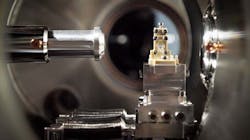World record: Laser-plasma accelerator operates continuously for 30 hours
Particle accelerators produce high-energy particles for research, medical, and other uses. Laser plasma accelerators promise to reduce the size of the active regions of these accelerators from meters to millimeters long. A team of researchers at the Deutsches Elektronen-Synchrotron (DESY; Hamburg, Germany) has reached an important milestone for these new accelerators: for the first time, a laser-plasma accelerator has run for more than a day while continuously producing electron beams. The LUX beamline, jointly developed and operated by DESY and the University of Hamburg, achieved a run time of 30 hours, producing more than 100,000 electron bunches at a rate of one per second.1
In the LUX laser-plasma accelerator, a strong laser pulse generates a plasma wave in nitrogen-doped hydrogen gas within a fine capillary by stripping electrons from the gas molecules. The electrons ride the wave like a surfer in the wake of a boat, pushing the electrons to high energies extremely quickly and within a short distance.
“The laser pulses plow their way through the gas in the form of narrow discs, stripping the electrons from the hydrogen molecules and sweeping them aside like a snowplow,” says DESY’s Andreas R. Maier, group leader at DESY's accelerator division and works at the Centre for Free-Electron Laser Science (CFEL), a joint enterprise between DESY, the University of Hamburg and the Max Planck Society.
Laser plasma accelerators achieve acceleration strengths that are up to a thousand times greater than what could be provided by today’s most powerful conventional accelerators. A number of technical challenges still need to be overcome before these devices can be put to practical use. “Now that we are able to operate our beamline for extended periods of time, we will be in a better position to tackle these challenges,” explains Maier.
In the DESY system, a Ti:sapphire drive laser provides 2 J, 42 fs pulses that are focused into the 4-mm-long plasma-cell target, ionizing gas to form a plasma that traps and accelerates electrons to an energy of 368 MeV. The electron beam is captured using a pair of electromagnetic quadrupoles and focused into a permanent-magnet dipole spectrometer. Retractable scintillating screens monitor the electron beam.
Large dataset aids future development
Thanks to the large dataset provided by the long operating time, the properties of the accelerator, the laser, and the bunches can be correlated and analyzed much more precisely. “Unwanted variations in the electron beam can be traced back to specific points in the laser, for example, so that we now know exactly where we need to start in order to produce an even better particle beam,” says Maier.
“This approach lays the foundations for an active stabilization of the beams, such as is deployed on every high performance accelerator in the world,” adds Wim Leemans, the director of DESY’s Accelerator Division.
Scientists from the University of Hamburg, the European ELI-Beamlines Project, the Max Planck Research School for Ultrafast Imaging & Structural Dynamics (IMPRS-UFAST) and DESY were all involved in the research.
Source: https://www.desy.de/news/news_search/index_eng.html?openDirectAnchor=1889
REFERENCE:
1. Andreas R. Maier et al., Physical Review X (2020); https://doi.org/10.1103/PhysRevX.10.031039.
About the Author
John Wallace
Senior Technical Editor (1998-2022)
John Wallace was with Laser Focus World for nearly 25 years, retiring in late June 2022. He obtained a bachelor's degree in mechanical engineering and physics at Rutgers University and a master's in optical engineering at the University of Rochester. Before becoming an editor, John worked as an engineer at RCA, Exxon, Eastman Kodak, and GCA Corporation.

